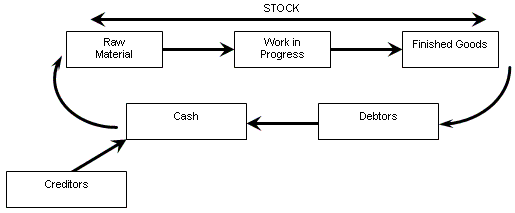
Ian McIsaac
Financial Training and Consultancy
| Home | Services | Learning Centre | Course Schedule | Clients | CV | Contact |
Back to main menu
3 |
The Financial Statements in Detail |
|
3.1 |
The Balance Sheet |
|
| The balance sheet provides information about the source of funds
for a business and how those funds have been used. The three sources
are share capital, loan capital and reserves and the three uses are
fixed assets, working capital and investments. It is now time to look
at the components of a balance sheet in more detail, explain the various
classifications of assets and liabilities and give more precise definitions
to all the relevant terms. We shall take as an example the recent balance sheets of a technology company. The information is taken from the group balance sheet of the annual report and the notes. Three years of information is provided so that we can make useful comparisons and identify changes over the period. |
||
 |
||
| We can identify the sources and uses of funds mentioned in chapter
one within these balance sheets. The share capital and profit and
loss reserve are to be found within equity shareholders’ funds
towards the bottom of the balance sheets (note the increase in accumulated
wealth over the three periods shown in the profit and loss reserve).
The equity shareholders’ funds represent the claim of the owners
against the business. The loan capital, together with other amounts
owing to organisations and individuals, are part of creditors due
within one year and creditors due after one year. These amounts are
the liabilities of the company. The fixed assets are shown clearly on the asset side of the balance sheet, and investments are normally shown as part of fixed assets (they may also appear as current assets if intended to be traded in the short term). Working capital includes the current assets of the business and is described more fully below. |
||
3.1.1 |
Balance Sheet Classifications |
|
| Let us look at the classifications of the assets, liabilities and
capital of the company as presented in the balance sheets above. These
are the items marked in bold type: fixed assets, current assets, creditors
due within one year, creditors due after one year and equity shareholders’
funds. The current assets are not permanent but are held as part of the day-to-day trading activities of the business. The old name for these types of asset was “circulating assets”. They are expected to be converted into cash (if not already cash) within 12 months. Fixed assets, on the other hand, are those assets held on a continuing basis in order to generate wealth e.g. buildings, vehicles, plant and equipment. A distinction is drawn between the creditors due within one year (also called current liabilities) and creditors due after one year. In both cases these are amounts owing to individuals and organisations. Equity shareholders’ funds are the residual item left over after all liabilities have been provided for (assets less liabilities = equity shareholders’ finds). It is the amount that ultimately ‘belongs’ to the shareholders. Equity shareholders’ funds can change as a result of the shareholders providing more funds to the business or from the trading transactions of the business resulting in it making profits or losses (see 1.4). |
||
3.1.2 |
Working capital |
|
| Working capital is often defined as the current assets less the current liabilities (or creditors due within one year). The working capital section of the balance sheet is a photograph of the trading cycle of the company at the balance sheet date. It shows the value of stock in the warehouses, the amounts owed by customers (trade debtors), the cash in the bank and the money the company owes to its suppliers (trade creditors). These four items – stock, trade debtors, cash and trade creditors – are the key elements of working capital. The working capital cycle is shown below. | ||
 |
||
| The cash conversion cycle is a way of measuring the time it takes
for the cycle to turn. The sequence is as follows. Cash is used to
purchase goods which are held as stock for a period of time (stock
days). These are then sold and, after a credit period, converted back
into cash (collection period). If credit is taken from a supplier
to help fund this process (payment period), this reduces the number
of days it takes for the cycle to turn. The cash conversion cycle
is stock days plus the collection period less the payment period.
For some food supermarkets the cycle is particularly advantageous
as stock is purchased from suppliers and held for, say, 14 days and
then cash is received immediately the goods are sold. It may be a
further 10 days or so before the suppliers are paid (the cash conversion
cycle is, in other words, about –10 days). Many industrial companies,
on the other hand, have cash conversion cycles in excess of 100 days
and this can be a restricting factor on them, especially in times
of growth (see 3.3.1).
Further explanation of the individual balance sheet items is to
be found later in the chapter. |
||
3.1.3 |
Formats of the Balance Sheet |
|
| The format of the balance sheet shown above – known as the
horizontal format - clearly shows the sources and uses of funds. However,
the balance sheet in an annual report is displayed in a vertical format.
The intention is to present the information from the shareholders’
point of view but arguably this form of presentation makes immediate
analysis more difficult. The vertical presentation format is shown
below: |
||
 |
||
3.1.4 |
What does the balance sheet tell us? |
|
| The balance sheet shows the accumulated wealth of a company as it
develops over time. A key measure of this accumulated wealth is the
extent to which shareholders’ funds have been increasing over
time and, in particular, whether reserves been built up as a result
of profits being ploughed back in to the business. The balance sheet also gives us information about the financial structure of a business. It is useful to examine the relative proportion of funds provided by the owners and retained profits as opposed to the external providers of finance. This involves comparing the extent to which the assets are financed by shareholders’ funds rather than the external creditors and, in particular, banks. Shareholders’ funds can be regarded as a ‘safety cushion’ in that the higher the proportion of shareholders’ funds to the total balance sheet, the less risky the business will be. This is because there is less reliance on ‘other people’s money’ and, in particular, loan capital. Debt can place heavy burdens on a company, especially when the business has to service interest and repay debt in difficult trading conditions. The ratio of interest-bearing debt to shareholders’ funds is known as gearing and total liabilities to shareholders’ funds as leverage. The higher these ratios, the more ‘risky’ the business will be. |
||
3.1.5 |
Explanation of Balance Sheet Terms |
|
| The terms are described in the order in which they appear on the
balance sheet of the technology company shown above.
Current Assets - These are assets that are already
cash or are expected to be turned into cash within the following
12 months. Tangible Fixed Assets - The tangible fixed assets have an underlying physical substance. They are shown in the balance sheet at their net book value i.e. after taking into account the ‘wear and tear’ (depreciation) that has affected the asset since it was first purchased. Investments - These are often investments in an associated company. An associate is where one company owns 20% or more (but not more than 50%) of the voting shares in another company. Goodwill - Assets that do not have an underlying physical substance - intangible assets - also sometimes appear on a balance sheet. Examples include patents, licenses, brand names and goodwill. Goodwill arises when one business purchases another and pays more than the value of the individual net assets acquired. The excess price paid is justified because it represents the intangibles over and above the acquired company’s asset base such as workforce skills, reputation, customer loyalty etc. These items are normally excluded from the balance sheet because they are so difficult to measure. Total Assets - The sum of current assets and fixed assets. This is the total size of the balance sheet. Creditors Due within One Year - These are amounts due for payment to outside parties within the next year and include bank loans/overdrafts, amounts due to suppliers (trade creditors), tax payments and dividends due to shareholders. Accrued Expenses - This relates to the accruals,
or matching, concept which is the principle that revenues and expenses
should be recognised in the period in which they are incurred, irrespective
of the time of the cash transaction. Thus, for example, a charge
would be recorded for the cost of gas in December, even though the
quarterly bill for payment might not arrive until February. In this
situation an accrued expense is shown on the balance sheet. Creditors due after One Year - Creditors due after
one year refer principally to the long-term loans or finance leases
extended to a company. The portion of long-term debt that is due
for repayment within the next year is shown as part of creditors
due within one year. Net Assets - Net assets are shown when the balance sheet is displayed in the vertical format. Net assets are total assets less total liabilities (total liabilities = creditors due within one year and creditors due after one year). Equity Shareholders’ Funds - These are the amounts which ultimately belong to the shareholders and consist of share capital, retained profits and other reserves. All are described below. Share Capital and Share Premium - Shares represent
the basic units of ownership of a business. Companies issue ordinary
shares which carry one vote each and an equal right to a proportionate
share of dividends. A company can issue shares up to the number
that has been ‘authorised’ by the shareholders. Reserves - The reserves consist of the share premium
account, the retained profits (profit and loss account) and any
revaluation reserve. A revaluation reserve will result from any
revaluation of the fixed assets of the company, likely to be land
or property. |
||
| Back to main menu |